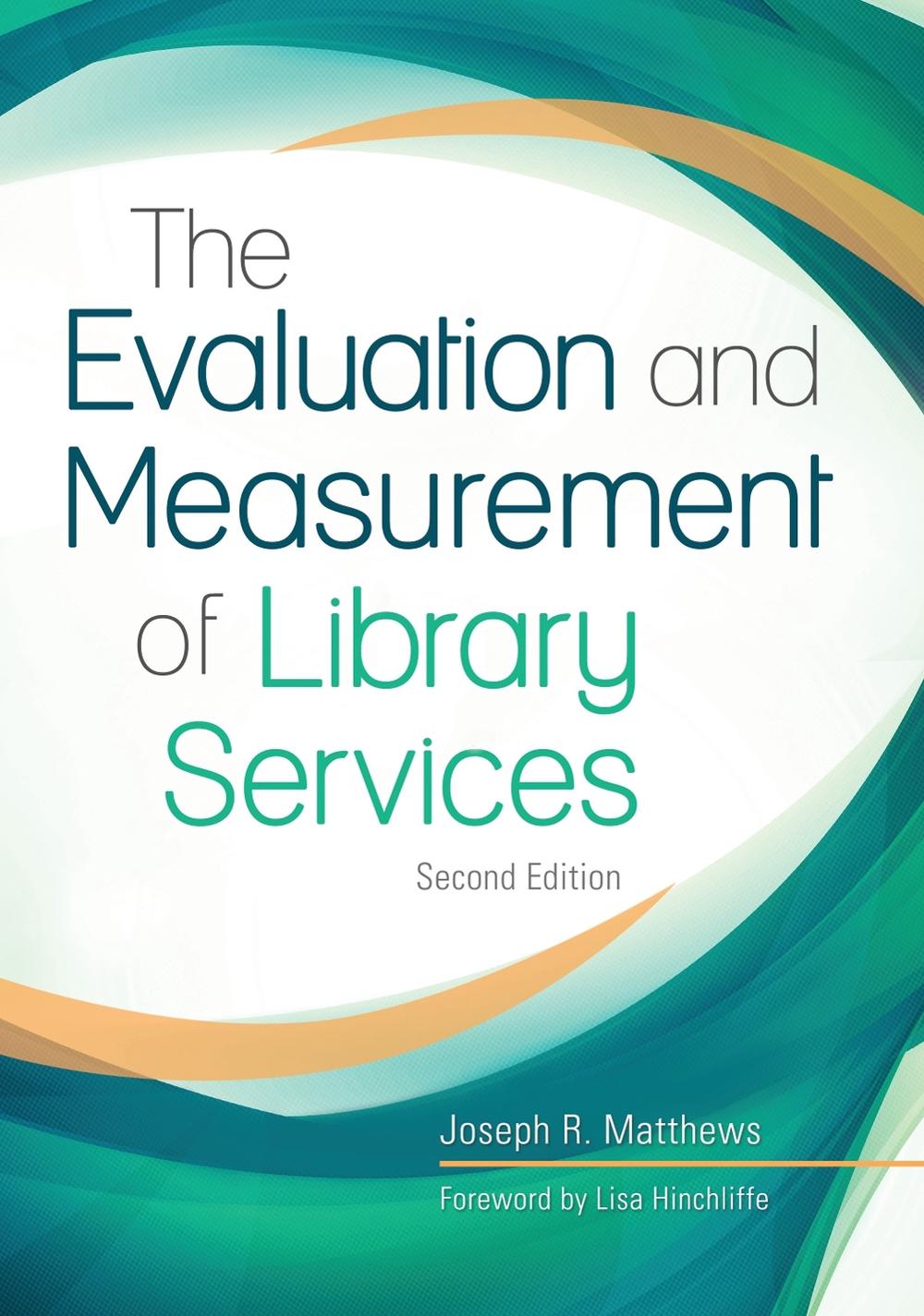
When you click on links to various merchants on this site and make a purchase, this can result in this site earning a commission. Affiliate programs and affiliations include, but are not limited to, the eBay Partner Network.
The Evaluation and Measurement of Library Services by Joseph R. Matthews (Englis

- Item No : 135710321126
- Condition : Brand New
- Brand : No brand Info
- Seller : the_nile
- Current Bid : US $146.76
-
* Item Description
-
The Nile on eBay

The Evaluation and Measurement of Library Services
by Joseph R. Matthews, Lisa Hinchliffe
This guide provides library directors, managers, and administrators in all types of libraries with complete and up-to-date instructions on how to evaluate library services in order to improve them.
It's a fact: today's libraries must evaluate their services in order to find ways to better serve patrons and prove their value to their communities. In this greatly updated and expanded edition of Matthews' seminal text, you'll discover a breadth of tools that can be used to evaluate any library service, including newer tools designed to measure customer and patron outcomes.
The book offers practical advice backed by solid research on virtually every aspect of evaluation, including quantitative and qualitative tools, data analysis, and specific recommendations for measuring individual services, such as technical services and reference and interlibrary loan. New chapters give readers effective ways to evaluate critical aspects of their libraries such as automated systems, physical space, staff, performance management frameworks, eBooks, social media, and information literacy.
The author explains how broader and more robust adoption of evaluation techniques will help library managers combine traditional internal measurements, such as circulation and reference transactions, with more customer-centric metrics that reflect how well patrons feel they are served and how satisfied they are with the library. By applying this comprehensive strategy, readers will gain the ability to form a truer picture of their library's value to its stakeholders and patrons.FORMAT
PaperbackLANGUAGE
EnglishCONDITION
Brand New
Author Biography
Joseph R. Matthews is president of JRM Consulting and has provided consulting assistance to numerous academic, public, and special libraries and local governments. He is editor of Public Library Quarterly and is on the editorial boards of Performance Measurement and Metrics and Library Hi Tech.
Table of Contents
Foreword
Acknowledgments
Introduction
Part I Evaluation: Process and Models
Chapter 1: Evaluation Issues
Who Decides
An Evaluation Action Plan
Identifying the Problem
Determining the Scope of the Analysis
Determining Whether the Answer Already Exists
Determining the Kind of Analysis to Do
Deciding What Data Will Be Needed
Conducting the Analysis and Preparing a Report
Using the Results for Service Improvement: The Feedback Loop
Obstacles to Evaluation
Ethics of Evaluation
Philosophical Question
Notes
Chapter 2: Evaluation Models
Evaluation Models
Other Notable Models
Limitations
Summary
Notes
Part II Methodology Concerns
Chapter 3: Qualitative Tools
No Contact
Examining Documents
Diaries
One-to-One Interaction
Observation
Interviewing
Grounded Theory
Think Aloud/Think After Verbal Protocol
Ethnographic Methods
Netnographic Methods
Phenomenography
Group Interaction
Focus Groups
Delphi Method
Critical Incident Technique
Concept Mapping
Analysis of Qualitative Data
Presentation of Findings
Summary
Notes
Chapter 4: Quantitative Tools
Counting
Measuring
Surveys
Types of Questions
Form of Questions
Question Construction
Distributing the Survey
Types of Sampling
Determining Sample Size
Survey Nonresponse
Caveats
Conjoint Analysis
Transaction Log Analysis
Experiments
Summary
Notes
Chapter 5: Analysis of Data
Descriptive Statistics Techniques
Thermometer Chart
Histogram
Frequency Polygon
Bar Charts
Line Charts
Pie Charts
Measures of Central Tendency
The Mode
The Median
The Mean
A Distribution's Shape
Measures of Variability
Range
Percentiles
Standard Deviation
Inferential Statistics
Visualization
Meta-Analysis
Summary
Notes
Part III Evaluation of Library Operations
Chapter 6: Evaluation of Operations
Benchmarking
Academic Library Statistics
Public Library Statistics
Activity-Based Costing
Step 1—Identify Key Activities and Relevant Cost Drivers
Step 2—Allocate Staff Time to Activities
Step 3—Attribute Staff Salaries and Other Costs to Activity Cost Pools
Step 4—Determine Cost Per Cost Driver
Cost-Benefit Analysis
Lean Tools
Statistical Process Control
Summary
Notes
Chapter 7: Evaluation of Technical Services
Service Definition
Evaluation Questions
Introduction
Evaluation Methods
Prior Evaluations and Research
Gathering Statistics
Time
Costs
Surveys
Workflow Analysis
Efficiency
Outsourcing
Quality
Enhanced Records
Summary
Notes
Chapter 8: Evaluation of Interlibrary Loan
Service Definition
Evaluation Questions
Evaluation Methods
Prior Evaluations and Research
Speed (Turnaround Time)
Fill Rate
Costs
Access versus Ownership
Requested Items Owned by the Library
Concentration and Scatter in Requested Materials
Impact of a Discovery Service
Other Topics
Patron-Driven Acquisitions
Customer Perspective
User Surveys
Interlibrary Loan Options
Best Practices
Summary
Notes
Chapter 9: Evaluation of Automated Systems
Service Definition
Evaluation Questions
Evaluation Methods
Prior Evaluations and Research
Next-Generation Library Management Systems
Merits of Cloud-Based Solutions
Open-Source Options
Merits of a Consortium
Discovery System Tradeoffs
Evaluating Web Sites
Increasing Bandwidth
Summary
Notes
Chapter 10: Evaluation of Automated Materials Handling Systems
Service Definition
Evaluation Questions
Evaluation Methods
Prior Evaluations and Research
RFID
Summary
Notes
Part IV Evaluation of Library Services
Chapter 11: Library Users and Nonusers
Service Definition
Evaluation Questions
Evaluation Methods
Prior Evaluations and Research
Demographics
Lifestyles
Geography
Volume of Use
Benefit Segmentation
Users
The Principle of Least Effort
Nonusers
Summary
Notes
Chapter 12: Evaluation of the Physical Collection
Service Definition
Evaluation Questions
Prior Evaluations and Research
Qualitative Methods
Quantitative Methods
Collection Development
Summary
Notes
Chapter 13: Evaluation of Electronic Resources
Service Definition
Evaluation Questions
Evaluation Methods
Prior Evaluations and Research
Users
Use
Analytics
Cost Analysis
Open-Access Journals
Customer Satisfaction
Accuracy
Impact on Print Journals
Impact on the Library
Value of E-Resources
Summary
Future Research
Notes
Chapter 14: Evaluation of E-Books
Service Definition
Evaluation Questions
Evaluation Methods
Prior Evaluations and Research
Comparing Availability of Print versus E-Books
Comparing Use of Print versus E-Books
Subject Area of Use
Customer Surveys
Consortia Purchases
Summary
Notes
Chapter 15: Evaluation of Reference Services
Service Definition
Evaluation Questions
Evaluation Methods
Prior Evaluations and Research
Libraries as a Source of Information
The READ Scale
Librarian Skills
Descriptive Analysis
Obtrusive Methods
A Library Survey
The WOREP Survey
Quick and Easy Reference Evaluation
Unobtrusive Testing
Observation
Conjoint Analysis
Cost-Benefit Analysis
Reference Resources
Summary
Notes
Chapter 16: Evaluation of Information Literacy
Service Definition
Evaluation Questions
Evaluation Methods
Prior Evaluations and Research
Opinion Surveys
Knowledge Testing
Actual Library Use
Student Retention Rates
Evaluation of Information Literacy Programs
Opinion Surveys
Skills Testing
Observed Behavior
Information Literacy Standards
Faculty–Librarian Relationships
Summary
Notes
Chapter 17: Evaluation of Summer Reading Programs
Service Definition
Evaluation Questions
Evaluation Methods
National Reading Studies
Prior Evaluation and Research
Qualitative Methods
Quantitative Methods
Suggested Best Practices
Summary
Notes
Chapter 18: Evaluation of Customer Service
Service Definition
Evaluation Questions
Evaluation Methods
Prior Evaluations and Research
Service Quality
Satisfaction
Methods for Determining Satisfaction
Combining Cost Per Use and Users' Satisfaction
LibQUAL+
LibSat
Local Library Surveys
Walking in the Shoes of the Customer
Defining Service Characteristics
Implementing Quality
Summary
Notes
Chapter 19: Evaluation of Social Media
Service Definition
Evaluation Questions
Evaluation Methods
Prior Evaluations and Research
Counts
Analysis of Comments
Surveys
Automated Tools
Metrics
Social Network Analysis
Return on Investment
Summary
Notes
Chapter 20: Evaluation of Physical Space
Service Definition
Evaluation Questions
Evaluation Methods
Prior Evaluations and Research
Interviews
Focus Groups
Design Charrette
Ethnographic Tools
Gate Counts
Floor Counts
Observation
Surveys
Summary
Notes
Chapter 21: Evaluation of the User Experience
Service Definition
Evaluation Questions
Evaluation Methods
Prior Evaluations and Research
Observation
Interviews and Focus Groups
Secret Shopper
Journey Mapping
Floor Counts
Usability Testing
Hierarchical Task Analysis
Web Analytics
Transaction Log Analysis
User Surveys
Ethnographic Methods
Summary
Notes
Part V Evaluation of Library Outcomes
Chapter 22: Evaluating the Broader Perspective
Library Goodness
The 90 Percent Library
Management Frameworks
Role of Performance Measures
Key Performance Indicators
Critical Success Factors
Process Improvement Initiatives
Self-Assessment Award Models
Performance Measurement Frameworks
Holistic Frameworks
Assessing the Frameworks
Notes
Chapter 23: Outcomes and Value
ISO 16439
Evaluation Methods
Library's Role in Student Learning
Library's Role in Student Retention
Library's Role in Teaching
School Libraries
Public Libraries
Summary
Notes
Chapter 24: Economic Impacts
Methodologies
Direct Survey
Duplication, Replication, and Complementarity
Client Value Model
Contingent Valuation
Consumer Surplus
A Shortcut Method
Value-Added Library Methodology
Formula Approach
Library ROI to Grants Income
Return on Capital Investment
Economic Impact Analysis
Economic Impact Studies
Data Envelopment Analysis
Other Methods
Summary
Notes
Chapter 25: Evaluation of Social Impacts
Qualitative Methods
The Social Audit
Quantitative Methods
Outcome Measures
Summary
Notes
Chapter 26: Communicating the Library's Story
Understand the Audience
Emphasize Benefits
Offer Context
Be Credible
Upgrade Communication Skills
Stage the Release of Information
Ask for Feedback
Summary
Notes
Author/Title Index
Subject IndexReview
…I would highly recommend this book to any librarian looking to do an evaluation of resource and services, individually or overall, or anyone interested in becoming an expert on the topic. * Technical Services Quarterly *
This publication provides a fantastic theoretical and practical guide to evaluating and assessing libraries. . . . The Evaluation and Measurement of Library Services is a great resource for all library professionals due to its impact on literally every aspect of library services and operations. * ARBA *Promotional
This guide provides library directors, managers, and administrators in all types of libraries with complete and up-to-date instructions on how to evaluate library services in order to improve them.
Long Description
It's a fact: today's libraries must evaluate their services in order to find ways to better serve patrons and prove their value to their communities. In this greatly updated and expanded edition of Matthews' seminal text, you'll discover a breadth of tools that can be used to evaluate any library service, including newer tools designed to measure customer and patron outcomes. The book offers practical advice backed by solid research on virtually every aspect of evaluation, including quantitative and qualitative tools, data analysis, and specific recommendations for measuring individual services, such as technical services and reference and interlibrary loan. New chapters give readers effective ways to evaluate critical aspects of their libraries such as automated systems, physical space, staff, performance management frameworks, eBooks, social media, and information literacy. The author explains how broader and more robust adoption of evaluation techniques will help library managers combine traditional internal measurements, such as circulation and reference transactions, with more customer-centric metrics that reflect how well patrons feel they are served and how satisfied they are with the library. By applying this comprehensive strategy, readers will gain the ability to form a truer picture of their library's value to its stakeholders and patrons.
Review Quote
"This publication provides a fantastical theoretical and practical guide to evaluating and assessing libraries. . . . The Evaluation and Measurement of Library Services is a great resource for all library professionals due to its impact on literally every aspect of library services and operations." - ARBA
Details
ISBN1440855366Author Lisa HinchliffeYear 2017Edition 2ndISBN-10 1440855366ISBN-13 9781440855368Format PaperbackCountry of Publication United StatesIllustrations 50DEWEY 025Language EnglishMedia BookPublication Date 2017-10-27Imprint Libraries Unlimited IncPlace of Publication EnglewoodUK Release Date 2017-10-27NZ Release Date 2017-10-27US Release Date 2017-10-27Edited by Joe Leeson-SchatzBirth 1945Death 1908Affiliation University of Southern QueenslandPosition ProfessorQualifications PhDAudience Age 7-17Pages 480Publisher Bloomsbury Publishing PlcEdition Description 2nd editionAudience Professional & VocationalAU Release Date 2017-10-26


-
- The Lost Super Foods
- $ 37.00
- The Self-Sufficient Backyard
- $ 37.00
- A Navy Seals BUG IN GUIDE
- $ 39.00
- Childrens Books Phonics Lot 60
- $ 34.99
















